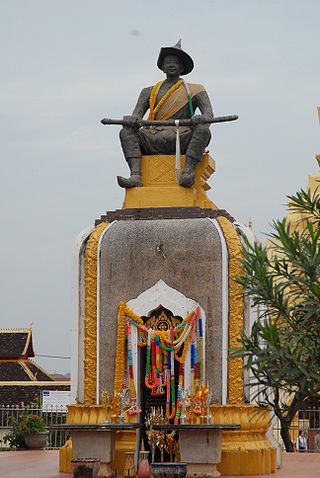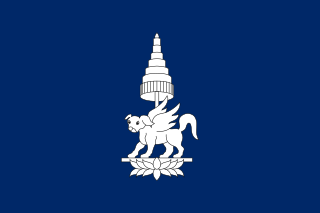![King Kham Souk of Champassak. H.H. Brhat Chao Yudhi Dharmadhara Negara Champasakti [Nyoutithammathone] [Nhutithamthorn], Prince of the State of Champasakti. Champassak-Kham-Souk.jpg](http://upload.wikimedia.org/wikipedia/commons/f/f0/Champassak-Kham-Souk.jpg)
Kham Souk was king of the southern Laotian Kingdom of Champasak from 1863 to 1899. He was preceded by Kham Nay, who reigned from 1856 to 1858, and a period of interregnum from 1858 to 1863. [1]
![King Kham Souk of Champassak. H.H. Brhat Chao Yudhi Dharmadhara Negara Champasakti [Nyoutithammathone] [Nhutithamthorn], Prince of the State of Champasakti. Champassak-Kham-Souk.jpg](http://upload.wikimedia.org/wikipedia/commons/f/f0/Champassak-Kham-Souk.jpg)
Kham Souk was king of the southern Laotian Kingdom of Champasak from 1863 to 1899. He was preceded by Kham Nay, who reigned from 1856 to 1858, and a period of interregnum from 1858 to 1863. [1]

The Lao Kingdom of Lan Xang Hom Khao existed as a unified kingdom from 1353 to 1707.

Luang Phabang, or Louangphabang, commonly transliterated into Western languages from the pre-1975 Lao spelling ຫຼວງພຣະບາງ as Luang Prabang, literally meaning "Royal Buddha Image", is a city in north central Laos, consisting of 58 adjacent villages, of which 33 comprise the UNESCO Town Of Luang Prabang World Heritage Site. It was listed in 1995 for unique and "remarkably" well preserved architectural, religious and cultural heritage, a blend of the rural and urban developments over several centuries, including the French colonial influences during the 19th and 20th centuries.
Chao Anouvong, or regnal name Xaiya Setthathirath V, , led the Lao rebellion (1826–28) as the last monarch of the Kingdom of Vientiane. Anouvong succeeded to the throne in 1805 upon the death of his brother, Chao Inthavong, Xaiya Setthathirath IV, who had succeeded their father, Ong Bun or Phrachao Siribounyasan Xaiya Setthathirath III. Anou was known by his father's regal number until recently discovered records disclosed that his father and brother had the same regal name.

Setthathirath or Xaysettha is considered one of the great leaders in Lao history. Throughout the 1560s until his death, he successfully defended his kingdom of Lan Xang against military campaigns of Burmese conqueror Bayinnaung, who had already subdued Xieng Mai in 1558 and Ayutthaya in 1564. Setthathirath was a prolific builder and erected many Buddhist monuments including Wat Xieng Thong in Luang Prabang, Haw Phra Kaew, Wat Ong Teu Mahawihan and the Pha That Luang in Vientiane.

Somdetch Brhat-Anya Fa Ladhuraniya Sri Sadhana Kanayudha Maharaja Brhat Rajadharana Sri Chudhana Negara, better known as Fa Ngum, established the Lao kingdom of Lan Xang in 1353.

Meuang Phuan or Xieng Khouang, also known historically to the Vietnamese as Trấn Ninh, was a historical principality on the Xiang Khouang Plateau, which constitutes the modern territory of Xiangkhouang Province, Laos.
Nang Keo Phimpha (1343–1438), an epithet meaning literally "The Cruel", was Queen of Lan Xang in 1438, taking the regnal name Samdach Brhat-Anya Sadu Chao Nying Kaeva Bhima Fa Mahadevi(Lao: ສົມເດັຈ ພຣະຍາ ສາທຸເຈົ້າຍິງ ແກ້ວພິມພາມະຫາເທວີ). She is also known by her title Maha Devi, and may have been the only reigning female sovereign of the kingdom of Lan Xang. According to some chronicles, she briefly occupied the throne for a few months, before she was deposed and killed at ninety-five years old. Her brief reign was the culmination of a ten-year period of regicide, which she orchestrated through a series of puppet kings.

The Franco-Siamese War of 1893, known in Thailand as Incident of R.S. 112 was a conflict between the French Third Republic and the Kingdom of Siam. Auguste Pavie, French vice consul in Luang Prabang in 1886, was the chief agent in furthering French interests in Laos. His intrigues, which took advantage of Siamese weakness in the region and periodic invasions by Vietnamese rebels from Tonkin, increased tensions between Bangkok and Paris. Following the conflict, the Siamese agreed to cede Laos to France, an act that led to the significant expansion of French Indochina.

The Kingdom of Champasak or Bassac, (1713–1904) was a Lao kingdom under Nokasad, a grandson of King Sourigna Vongsa, the last king of Lan Xang and son-in-law of the Cambodian King Chey Chettha IV. Bassac and the neighboring principalities of Attapeu and Stung Treng emerged as power centers under what was later to be described as the Mandala Southeast Asian political model.
Huy was prince-governor of the Siamese vassal Kingdom of Champasak in southern Laos from 1827 to 1840.
Kham Nai was king of the southern Laotian Kingdom of Champasak from 1856 to 1858.

The Kingdom of Luang Phrabang, also called Kingdom of Luang Prabang was formed in 1707 as a result of the split of the Kingdom of Lan Xang. When the kingdom split, Muang Phuan became a tributary state of Luang Prabang. Over the years the monarchy weakened even more, and was forced to become a vassal various times to the Burmese and the Siamese monarchies.
Kham Ouane Boupha is a Laotian soldier and politician. Appointed to command Phongsali Province in the Kingdom of Laos in 1957 or 1958 while he was in his mid-twenties, he would maintain that base throughout the impending Laotian Civil War. During that war, in April 1963, he would defect from government service to head the pro-communist Patriotic Neutralists movement. At the end of the war, as the Communists succeeded to power through the Provisional Government of National Union, Kham Ouane Boupha was appointed Deputy Minister of Defense on 9 April 1974. He was promoted to become Minister of Defense on 12 May 1975 and served as such for many years, even while he was also Minister of Justice. He retired from cabinet rank in 2006, becoming a Minister in the Office of the Prime Minister.
Chakkaphat Phaen Phaeo (1415–1481) reigned as King of Lan Xang from 1442 to 1480, succeeding the Maha Devi after an interregnum of several years. He was born in 1415 as Prince Vong Buri, the youngest son of King Samsenthai by Queen Nan Keo Yot Fa daughter of King Intharacha of Ayutthaya. When he came of age he was appointed as Governor of Vientiane. He was invited to ascend the throne several times during the succession dispute orchestrated by the Maha Devi, but refused. The Council of Ministers finally persuaded him to become king in 1441, after they had failed to find any other candidate. He still refused to be crowned and avoided the ceremony for many years. Finally bowing to custom in 1456, he was formally coroneted and assumed the reign name and title of Samdach Brhat-Anya Chao Sanaka Chakrapati Raja Phen-Phaeo Bhaya Jayadiya Kabuddha. The regnal name is significant because it translates in Pali to cakkavattin, meaning "Universal Buddhist Monarch." Vong Buri, and the court, were claiming enough political and religious power to unify the kingdom, and warn surrounding kingdoms, despite the upheaval caused by the Maha Devi and interregnum in Lan Xang from 1428-1442.
Souvanna Banlang (1455-1486) was king of Lan Xang from 1479-1486 taking the regnal name Samdach Brhat-Anya Chao Suvarna Panya Lankara Raja Sri Sadhana Kanayudha. His reign was marked as a period of peace and reconstruction, following a massive invasion by the Đại Việt forces of Emperor Lê Thánh Tông. He became king in 1479 after the abdication of his father Chakkaphat Phaen Phaeo, who had fled the capital of Muang Sua ahead of the Đại Việt armies. Prior to his accession he served as Governor of Muang Dansai, according to the Lao chronicles he commanded Lao forces at the Battle of Pakphun where the invading forces were halted and forced to retreat to Vietnam.
Mon Keo was the king of the Laotian Kingdom of Lan Xang between 1627 and 1633, Reigning with the regnal name of Samdach Brhat-Anya Chao Manikya Kaeva Raja Sri Sadhana Kanayudha, he was the son of King Voravongsa II and brother of King Ouphagnauvarath I.
Tone Kham was the king of the Laotian Kingdom of Lan Xang between 1633 and 1637. He was the elder son of King Mon Keo.
Vichai was the king of the Kingdom of Lan Xang between 1637–1638.

Princess Sao Sanda is the last princess of Yawnghwe, a now disestablished Shan state in present-day Myanmar. She is the eldest daughter of the last Saopha of Yawnghwe Sao Shwe Thaik by his consort Sao Nang Sanda. A journalist at Reuters, she coauthored several books with her husband Peter Simms. Her 2008 book The Moon Princess: Memories of the Shan States chronicles a turbulent period in Burma's history, providing both her life story and a chronicle of her father, the first president of the Union of Burma after its independence.